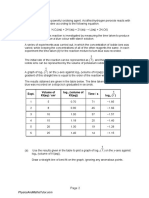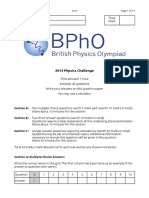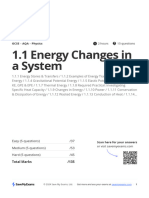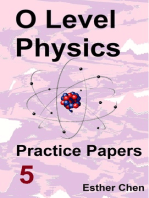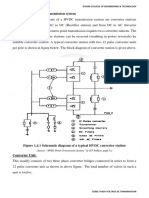Oxo AQA16 P1uu T801 Xxaann
Oxo AQA16 P1uu T801 Xxaann
Uploaded by
4cpzx7fp52Copyright:
Available Formats
Oxo AQA16 P1uu T801 Xxaann
Oxo AQA16 P1uu T801 Xxaann
Uploaded by
4cpzx7fp52Original Title
Copyright
Available Formats
Share this document
Did you find this document useful?
Is this content inappropriate?
Copyright:
Available Formats
Oxo AQA16 P1uu T801 Xxaann
Oxo AQA16 P1uu T801 Xxaann
Uploaded by
4cpzx7fp52Copyright:
Available Formats
P1 Aiming for 8
Student checkpoint follow-up
Name...................................................................... Class................... Date......................
P1 Conservation and dissipation of energy – Aiming
for Grade 8
Aims
You will complete investigations into balls that bounce and balls that make
craters in sand.
Using liquid and coins, you will model processes where energy is transferred
from one form to another. You will practise calculations involving gravitational
potential energy, kinetic energy, elastic potential energy, work done, power, and
efficiency. You will consider situations where energy is wasted, and how that
situation links to the idea of dissipation.
You will analyse data about different types of lamps and how the data links to
efficiency.
Learning objectives
After completing this activity, you should be able to:
describe processes in terms of energy stores
do calculations involving gravitational potential energy, kinetic energy,
elastic potential energy, work done, power, and efficiency; including changing the
subject of an equation
apply what you know about power and efficiency.
Safety
Clear up any spillages of the liquid so they do not cause a hazard.
Equipment
Part 1
Bouncy balls
Tray of sand
Metre ruler
Digital balance (to measure mass of balls)
Part 2
Four 250 ml beakers
Coloured liquid
Pieces of card, about 8 cm 3 cm to use as labels
Elastic bands to secure labels to beakers
Coins or counters
Part 3
Graph paper
Calculator
© Oxford University Press 2016 www.oxfordsecondary.co.uk/acknowledgements
This resource sheet may have been changed from the original. 1
P1 Aiming for 8
Student checkpoint follow-up
Name...................................................................... Class................... Date......................
Task
Part 1: Energy conservation and calculations
When you drop a ball on the floor it bounces, but when you drop it into sand it
makes a crater.
A Design an investigation to find the fraction of gravitational potential energy
transferred to the surroundings on each bounce of a ball on the floor.
and/or
B Design an investigation to find the relationship between the drop height of a
ball and the diameter of the crater that it makes in sand.
You will need to devise appropriate methods to measure the height of the bounce
and the diameter of the crater.
Part 2: Modelling energy transfer and dissipation
Modelling is a very useful way to understand what is happening in a process
where you cannot see the detail of what is happening. This is how you could
model a ball falling to the ground:
Step 1: Identify the store that has more energy at the start point – that is,
before the ball is dropped.
At the start there is more energy in the gravitational store.
Step 2: Identify the store that has more energy at the end – that is, just
before the ball hits the ground.
At the end there is more energy in the kinetic store.
Label beakers with the stores: gravitational and kinetic. Pour the liquid into
the one at the start. Then transfer the ‘energy’ to the store at the end.
Think which other stores might fill up as well.
A Use the method described above to model energy transfers in the two
experiments in Part 1 of the Task.
B Another way of modelling energy transfer is to use coins or counters to
represent small ‘units of energy’. Work out a way to model energy transfers in
a process or device by just using the coins or counters.
© Oxford University Press 2016 www.oxfordsecondary.co.uk/acknowledgements
This resource sheet may have been changed from the original. 2
P1 Aiming for 8
Student checkpoint follow-up
Name...................................................................... Class................... Date......................
Part 3: Power and efficiency
Light bulb technology has improved considerably over the last 20 years. You may
have noticed how many objects, like traffic lights, now use LEDs.
A Look at the table that shows the total power input of three different types of
light bulb required to produce different light intensities. Present this data on a
suitable graph.
Light intensity Power of incandescent Power of CFL (energy Power of LED
in lumens light lamp in W saving) light lamp in W light in W
450 40 10 7.5
800 60 15 10.0
1400 75 20 14.0
1800 100 25 18.0
2800 150 45 16.0
B Incandescent light bulbs are about 10% efficient. Use the information in the
table to estimate the efficiency of CFL and LED lamps.
Questions
Part 1: Energy conservation and calculations
1 List the different types of energy store, and ways of transferring energy
between stores.
(2 marks)
2 a Describe what we mean by ‘work’ in science.
(1 mark)
© Oxford University Press 2016 www.oxfordsecondary.co.uk/acknowledgements
This resource sheet may have been changed from the original. 3
P1 Aiming for 8
Student checkpoint follow-up
Name...................................................................... Class................... Date......................
b Explain why when you lift an object the work done is equal to the change in
gravitational potential energy, but when you push an object across a desk it is
not.
(6 marks)
3 a Compare the final energy stores between a ball which is dropped above
the floor and bounces back to a portion of its original height, and another
ball which is dropped and makes a crater in the sand below.
(3 marks)
b Compare the work done, both for the ball which is dropped above the floor and
bounces back to a portion of its original height, and for the other ball which is
dropped and makes a crater in the sand below.
(6 marks)
© Oxford University Press 2016 www.oxfordsecondary.co.uk/acknowledgements
This resource sheet may have been changed from the original. 4
P1 Aiming for 8
Student checkpoint follow-up
Name...................................................................... Class................... Date......................
4 a Explain how to calculate the speed of a ball just before it hits the ground if
it is dropped from a height of 1 m, stating any assumptions that you make.
(3 marks)
b Use your answer to part a to explain why the speed of a falling object does
not depend on mass.
(1 mark)
c State whether, in reality, the speed of the ball will be greater than, less
than, or the same as the speed calculated and explain why.
(2 marks)
5 A student drops a spring onto the ground and the spring compresses. The
mass of the spring is 0.25 kg and the spring constant of the spring is 1 kN/m.
a Complete the table. You will need to use the equation:
elastic potential energy (Ee) spring constant (k) extension2 (e2).
(3 marks)
Height dropped Gravitational potential Elastic potential Compression of
from in m energy, Ee in J energy, Ee in J spring in m
1.00
0.50
0.25
b State an assumption that you have made.
(1 mark)
© Oxford University Press 2016 www.oxfordsecondary.co.uk/acknowledgements
This resource sheet may have been changed from the original. 5
P1 Aiming for 8
Student checkpoint follow-up
Name...................................................................... Class................... Date......................
Part 2: Modelling energy transfer and dissipation
6 Describe how you modelled energy with the coins.
(3 marks)
7 For all of the processes that you modelled, some energy ends up in the
surroundings.
a Name two processes that transfer energy to the surroundings.
(2 marks)
b Explain why energy transferred to the surroundings is ‘dissipated’.
(1 mark)
c Explain why the energy in the chemical store of the petrol in the fuel tank
of a car that takes you to school is eventually dissipated.
(3 marks)
Part 3: Power and efficiency
8 Write down two equations that you can use to calculate power.
(2 marks)
9 a Complete the table by calculating the power. (2 marks)
Device Energy in kJ Time Power
shower 60 1 minute
refrigerator 4.8 1 day
low-energy lamp 252 7 hours
hairdryer 576 12 minutes
© Oxford University Press 2016 www.oxfordsecondary.co.uk/acknowledgements
This resource sheet may have been changed from the original. 6
P1 Aiming for 8
Student checkpoint follow-up
Name...................................................................... Class................... Date......................
b Complete the table and calculate the efficiency. (4 marks)
Device Useful energy in J Wasted energy in J Total energy in J Efficiency
light bulb 5 25
kettle 500 2000
television 2500 2500
car 100 400
c Explain how you knew how to complete the middle three columns of
the table.
(2 marks)
10 Look at the graph that you plotted for Part 3 of the Task.
a Consider an incandescent light bulb, CFL, and LED that all provide a light
intensity of 1400 lumens. If an incandescent light bulb is 10% efficient calculate
the useful power output of the incandescent bulb.
(2 marks)
b i State and explain an assumption that you can make in order to be able
to calculate the efficiencies of the other two lamps.
(2 marks)
ii Calculate the efficiency of a CFL.
(2 marks)
iii Calculate the efficiency of an LED.
(2 marks)
© Oxford University Press 2016 www.oxfordsecondary.co.uk/acknowledgements
This resource sheet may have been changed from the original. 7
P1 Aiming for 8
Student checkpoint follow-up
Name...................................................................... Class................... Date......................
c Suggest and explain a link between the graph and the efficiency of each lamp.
(2 marks)
d Suggest why it may not reduce your energy bills if you replace light bulbs
with energy saving devices.
(3 marks)
© Oxford University Press 2016 www.oxfordsecondary.co.uk/acknowledgements
This resource sheet may have been changed from the original. 8
You might also like
- P8 Forces in BalanceDocument6 pagesP8 Forces in BalanceJuyeon Nam100% (1)
- PestleDocument8 pagesPestleapi-659085933No ratings yet
- P1.2 Student Practical: Bungee JumpingDocument6 pagesP1.2 Student Practical: Bungee JumpingAlenNo ratings yet
- MONOSLOPE Roof Open Building TERRACE Wind LoadsDocument2 pagesMONOSLOPE Roof Open Building TERRACE Wind LoadsAnkita Pal100% (2)
- Topic 4.1 Formative Answer KeyDocument2 pagesTopic 4.1 Formative Answer Key이수연No ratings yet
- P10.1 Student Calculation Sheet: Force, Mass, and AccelerationDocument4 pagesP10.1 Student Calculation Sheet: Force, Mass, and AccelerationBenjamin WatsonNo ratings yet
- Oxo AQA16 P1uu T401 XxaannDocument7 pagesOxo AQA16 P1uu T401 Xxaann2020-6582No ratings yet
- Oxo AQA16 P2uu T801 XxaannDocument9 pagesOxo AQA16 P2uu T801 XxaannSunaina BadhanNo ratings yet
- P1 Exam questions ELADocument5 pagesP1 Exam questions ELAAyman No ratings yet
- P1.3 Doing Work Practical SheetDocument4 pagesP1.3 Doing Work Practical Sheet21tahiradamNo ratings yet
- P1.1 Student Working Scientifically: Energy AnalogiesDocument4 pagesP1.1 Student Working Scientifically: Energy AnalogiesAlenNo ratings yet
- P1.2 Student Practical: Investigating PendulumsDocument6 pagesP1.2 Student Practical: Investigating PendulumsAlenNo ratings yet
- alternating-current generatorSDocument8 pagesalternating-current generatorSAyman No ratings yet
- Oxo AQA16 P4uu T401 XxaannDocument6 pagesOxo AQA16 P4uu T401 Xxaannsalt saltNo ratings yet
- Topic 5 Forces and Motion HDocument17 pagesTopic 5 Forces and Motion HHerry CenNo ratings yet
- Oxo AQA16 P7uu T801 CsaannDocument10 pagesOxo AQA16 P7uu T801 CsaannemailusageNo ratings yet
- Physics Unit 1Document19 pagesPhysics Unit 1mariam saidNo ratings yet
- P15.1 Student Bump Up Your Grade: Magnets and Magnetic FieldsDocument5 pagesP15.1 Student Bump Up Your Grade: Magnets and Magnetic FieldsBenjamin WatsonNo ratings yet
- Determination of Rate Equation - 2 QPDocument12 pagesDetermination of Rate Equation - 2 QPSalman ZaidiNo ratings yet
- IMSO 2015 SCIENCE Theoretical 2Document15 pagesIMSO 2015 SCIENCE Theoretical 2Thanh DinhNo ratings yet
- Chapter 8 QuestionsDocument6 pagesChapter 8 QuestionsMo KhNo ratings yet
- Lesson 16 - Energy, Motion & Pressure Revision TasksDocument13 pagesLesson 16 - Energy, Motion & Pressure Revision Tasksminal.thee.greatNo ratings yet
- G6 UA1 Alternate Test Phy QPDocument7 pagesG6 UA1 Alternate Test Phy QPDhruv CVNo ratings yet
- IMSO 2015 SCIENCE Theoretical 2Document13 pagesIMSO 2015 SCIENCE Theoretical 2MurniNo ratings yet
- Measurement (Answers)Document16 pagesMeasurement (Answers)keyur.galaNo ratings yet
- Forces - Elasticity 2 QPDocument17 pagesForces - Elasticity 2 QPRenga RajaNo ratings yet
- Change in Energy and Energy Transformations AnsDocument33 pagesChange in Energy and Energy Transformations Anslokapavani_senthilNo ratings yet
- 2018 PDFDocument12 pages2018 PDFDiaa SaberNo ratings yet
- Electricity Worksheet Physics GcseDocument5 pagesElectricity Worksheet Physics Gcsetun1123tNo ratings yet
- Igcse 91 Energy QPDocument20 pagesIgcse 91 Energy QPChan Nyein Kyal SinNo ratings yet
- Supplemental ProblemsDocument64 pagesSupplemental Problems249859104171% (7)
- Physics Challenge 2014 Question PaperDocument13 pagesPhysics Challenge 2014 Question PaperNitin Sharma100% (1)
- Year 8 Eote 2023-2024Document20 pagesYear 8 Eote 2023-2024abdirahmanbishaar1394No ratings yet
- 0625 Y14 SQ 191114Document114 pages0625 Y14 SQ 191114mydadawalfnNo ratings yet
- LightDocument8 pagesLightcxsdvNo ratings yet
- Oxo Aqa16 c7ss xq02 XxaannDocument5 pagesOxo Aqa16 c7ss xq02 Xxaann20hthiyagarajanjNo ratings yet
- 5054 s16 QP 21Document20 pages5054 s16 QP 21pixelhoboNo ratings yet
- 2007 iGCSE Physics Written Paper Question PaperDocument28 pages2007 iGCSE Physics Written Paper Question Paperoscar wildeNo ratings yet
- Coimisiún Na Scrúduithe Stáit State Examinations Commission: Leaving Certificate ExaminationDocument12 pagesCoimisiún Na Scrúduithe Stáit State Examinations Commission: Leaving Certificate Examinationfrank mutaleNo ratings yet
- Coimisiún Na Scrúduithe Stáit State Examinations Commission: Leaving Certificate ExaminationDocument12 pagesCoimisiún Na Scrúduithe Stáit State Examinations Commission: Leaving Certificate Examinationfrank mutaleNo ratings yet
- Topic 5 Forces and Motion FDocument20 pagesTopic 5 Forces and Motion FA DasNo ratings yet
- A2 Extended Writing PracticeDocument116 pagesA2 Extended Writing PracticeBudi LindrawatiNo ratings yet
- Oxo Aqa16 p8cs xq01 XxaannDocument6 pagesOxo Aqa16 p8cs xq01 XxaannAlt BoiNo ratings yet
- P12.3 WSDocument4 pagesP12.3 WStholmesNo ratings yet
- Oxo Act02 p209 As01 XxaannDocument7 pagesOxo Act02 p209 As01 XxaannAditya SarmaNo ratings yet
- Change in Energy - Energy TrasformationDocument25 pagesChange in Energy - Energy Trasformationlokapavani_senthilNo ratings yet
- H556-03 QP Jun22Document20 pagesH556-03 QP Jun22Ali ANo ratings yet
- Work-Energy-Power: IB Questionbank PhysicsDocument27 pagesWork-Energy-Power: IB Questionbank PhysicsDURU ALTINKAYANo ratings yet
- 1 1 Energy Changes in A System 8q5EDVo84now1kxYDocument33 pages1 1 Energy Changes in A System 8q5EDVo84now1kxYsnimra2233No ratings yet
- What Do They Mean : DefineDocument3 pagesWhat Do They Mean : DefineLabeenaNo ratings yet
- Worksheet: Hooke's Law: Q1.A Student Suspended A Spring From A Laboratory Stand and Then Hung A Weight From TheDocument11 pagesWorksheet: Hooke's Law: Q1.A Student Suspended A Spring From A Laboratory Stand and Then Hung A Weight From Thefatimahehe31323No ratings yet
- Cambridge IGCSE: PHYSICS 0625/31Document20 pagesCambridge IGCSE: PHYSICS 0625/31Nisha zehraNo ratings yet
- Pre-Leaving Certiϐicate Examination, 2019 Triailscrúdú Na Hardteistiméireachta, 2019Document12 pagesPre-Leaving Certiϐicate Examination, 2019 Triailscrúdú Na Hardteistiméireachta, 2019Diaa SaberNo ratings yet
- IX E-ATP-Hooke's LawDocument4 pagesIX E-ATP-Hooke's Lawdmoolchandani515No ratings yet
- Paper PhysicsDocument16 pagesPaper PhysicsruukiNo ratings yet
- Energy Changesina SystemDocument74 pagesEnergy Changesina SystemCally ChewNo ratings yet
- P3 Chapter 1 End-Of-Chapter Test (Foundation)Document6 pagesP3 Chapter 1 End-Of-Chapter Test (Foundation)Paul LloydNo ratings yet
- Fluid. Answer in Answer SpaceDocument15 pagesFluid. Answer in Answer SpacehumeraNo ratings yet
- Edexcel Physics A2 Coursework PendulumDocument6 pagesEdexcel Physics A2 Coursework Pendulumdrrzjaifg100% (2)
- 3.1.2 Limitation of Physical MeasurementsDocument16 pages3.1.2 Limitation of Physical Measurementsdhruvsolanki08052007No ratings yet
- Elettrodo Rutil-Cellulosico AWS A5.1 - E6013 (Elga P45-S)Document1 pageElettrodo Rutil-Cellulosico AWS A5.1 - E6013 (Elga P45-S)Eraldo MigliavaccaNo ratings yet
- Analysis of Extra High Voltage Ac TransmissionDocument18 pagesAnalysis of Extra High Voltage Ac TransmissionravihctmNo ratings yet
- Section 35 - Hydraulic System - Chapter 9Document46 pagesSection 35 - Hydraulic System - Chapter 9Cristian SterieNo ratings yet
- Portable Air Conditioner With Heat Pump: BPACT12H BPACT14HDocument48 pagesPortable Air Conditioner With Heat Pump: BPACT12H BPACT14HTerrence JonesNo ratings yet
- CT365 CT400S (QSG12 50Hz)Document3 pagesCT365 CT400S (QSG12 50Hz)Md ShNo ratings yet
- Development of Laundry Soap From Jatropa, Castor and Palm OilsDocument4 pagesDevelopment of Laundry Soap From Jatropa, Castor and Palm OilsLeencie Sande100% (1)
- Ele - Aos101eba2 268202-1Document12 pagesEle - Aos101eba2 268202-1pratamaNo ratings yet
- 1 s2.0 S0950061823007705 MainDocument13 pages1 s2.0 S0950061823007705 MainEverton AndradeNo ratings yet
- Energy Audit PPT EditedDocument12 pagesEnergy Audit PPT EditedwwwNo ratings yet
- Sample Paper-Campus Recruitment Test-Physics EnggDocument6 pagesSample Paper-Campus Recruitment Test-Physics EnggPRIYANSHU GOELNo ratings yet
- Lecture #32 - Summary Muons - An Example of Time Dilation and Length ContractionDocument4 pagesLecture #32 - Summary Muons - An Example of Time Dilation and Length ContractionMargaret OnuNo ratings yet
- Inverter Type (Wall-Mounted) Trouble Shooting Guide: No. Problems Indoor Error Code Outdoor Display SolutionDocument3 pagesInverter Type (Wall-Mounted) Trouble Shooting Guide: No. Problems Indoor Error Code Outdoor Display SolutionMaria Stan100% (1)
- RFQ - Swimming PoolDocument4 pagesRFQ - Swimming Poolrkpatel40No ratings yet
- Water Market Standard Supplier ListDocument12 pagesWater Market Standard Supplier Listsales3No ratings yet
- Chapter 2 Leaf Structure and Function (Biology SPM)Document12 pagesChapter 2 Leaf Structure and Function (Biology SPM)ALAMEL MANZGHAI A/P GANESONNo ratings yet
- Heat Treatment Procedure.Document15 pagesHeat Treatment Procedure.Vijay ShamNo ratings yet
- General Physics 2Document9 pagesGeneral Physics 2nics comiaNo ratings yet
- HVDC Transmission Basic CircuitDocument3 pagesHVDC Transmission Basic CircuitDEPARTMENT OF EEE SVEWNo ratings yet
- Hvac System For Sensible Building by Victimisation Using ArduinoDocument6 pagesHvac System For Sensible Building by Victimisation Using ArduinoInternational Journal of Innovative Science and Research TechnologyNo ratings yet
- Subsea Engineer Resume 2023 JulyDocument3 pagesSubsea Engineer Resume 2023 JulyAchanta Mounica100% (1)
- Hotplate Magnetic Stirrer Assignment 1Document4 pagesHotplate Magnetic Stirrer Assignment 1Mervin RecolitoNo ratings yet
- Design and Performance of A Light Sport Airplane: Standard Specification ForDocument34 pagesDesign and Performance of A Light Sport Airplane: Standard Specification ForLois MeiraNo ratings yet
- Marine and Offshore Pumping and Piping SystemsDocument390 pagesMarine and Offshore Pumping and Piping SystemscarloslokiNo ratings yet
- Electrical BOQ Plot C LPSDocument5 pagesElectrical BOQ Plot C LPSAgrawal PrajaktaNo ratings yet
- Zx33u 5aDocument20 pagesZx33u 5aEVA Rental AdminNo ratings yet
- Peugeot Engine Identification CodesDocument3 pagesPeugeot Engine Identification CodesBill jonesNo ratings yet
- Physics SQP - 11 Latest (2023) Class 12 CBSEDocument27 pagesPhysics SQP - 11 Latest (2023) Class 12 CBSEmr mindNo ratings yet


















